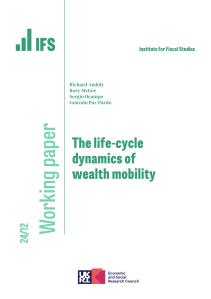Those getting financial help receive an average of £25,000, making up almost half of their deposit. These wealth transfers help many of those who receive them to purchase a home sooner, while also enabling some buyers to put down a larger deposit as a proportion of the house price, substantially reducing their mortgage interest payments.
These are among the findings of a new IFS report, funded by the Economic and Social Research Council, examining the patterns of financial help for first-time home buyers. Other key findings include:
Homeownership rates have fallen steeply in recent years, in particular for those whose parents don’t own their own home:
- The homeownership rate for those aged between 25 and 39 whose parents owned their own home fell from 60% in 2009 to 51% in 2019. Among those whose parents rented their home, it fell from 40% to 22% over the same period.
- This means that the children of homeowners are now over twice as likely to be homeowners as the children of renters.
Parental assistance plays a significant role in driving homeownership inequalities:
- Over half of those with university-educated homeowning parents received transfers when buying for the first time, with receivers getting an average of around £35,000. Of those whose parents rented their home, only 29% drew on financial help when buying their home, with receivers getting an average transfer of just £11,000.
- Differences in financial resources, including assistance received, can explain almost half of the difference in home purchase rates between those with better-off and worse-off parents, holding incomes and ages constant.
- Among first-time buyers receiving financial help, those in the South East received an average of around £31,000, while those in the Midlands received £18,000 on average and those in the North received £17,000.
Financial transfers can have a particularly large effect on the ability to afford a house for those who have relatively low savings:
- For almost two-thirds of first-time buyers, each £1,000 they receive from parents increases the value of the house they can buy not by £1,000 but by £10,000, assuming they must put down a 10% deposit. This is because their low savings restrict the deposit they can put down and determine the most expensive property they can buy.
- Those first-time buyers at younger ages, with less-wealthy parents, and living outside of the South East are more likely to be held back by their low savings in this way. For these people, transfers have a more transformative effect on what they can afford.
Rather than just helping people to be able to afford to buy, financial help is often used to put down a larger deposit. This tends to have very high financial returns because it reduces the interest rate paid on the whole mortgage:
- Among those who receive a transfer when buying a house, each additional pound received in transfers is associated with putting an additional 77p down as a deposit.
- Using a typical transfer of £25,000 to put down a deposit of 25% rather than 10% of the house value would reduce the repayments on a typical five-year fixed rate mortgage taken out in 2018 by £8,500. This compares to a return of around £850 if putting this in a typical cash ISA.
- As a result of this, financial help is likely to drive increased wealth accumulation for those who receive more, compared to those who receive less or nothing.










